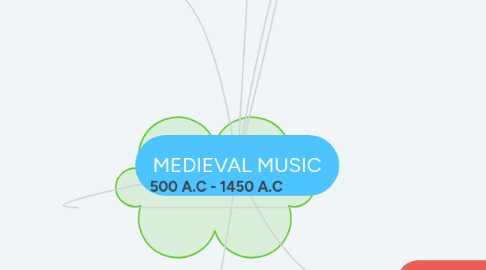
1. Music also comes with poetry and dance.
2. WHAT WAS MUSIC USED FOR
2.1. RITUALS
2.2. WORSHIP
2.3. WORKSONG
2.4. ENTERTAINMENT
2.4.1. SONGS
2.4.1.1. Simple, monophic, often with accompainment from a pipe and tambor or tambourine.
2.4.1.2. Wandering Musicians
2.4.1.3. The earliest songs were composed by troubadours and minstrels
2.4.2. DANCES
2.4.2.1. Dances may be played by one or two instruments or by a larger group
2.4.2.2. Estampie (a stamping dance) and the Saltarello (a jumping dance)
3. 500 A.C - 1450 A.C
4. ROOTS OF WESTERN MUSIC
4.1. For greek people, music was an art of divine origin.
4.2. They trought music had magical powers that could cure illnesses.
4.3. The used four modal scales
4.3.1. Dorian
4.3.2. Phrygian
4.3.3. Lydian
4.3.4. Mixolydian
4.4. This music has a monodic texture with only one melodic line.
4.5. Exampels of instruments
4.5.1. Lyre (linked to Apollo)
4.5.2. Aulos (linked to Dionysus)
5. INSTRUMENTS
5.1. OUTDOOR
5.1.1. For a performance of music in halls and churches, processions and dances in the open air.
5.1.1.1. The shawn
5.1.1.2. The pipe and the Tambor
5.1.1.3. The nackers
5.1.1.4. The Bagpipes
5.1.1.5. The cornet
5.2. INDOOR
5.2.1. For a preformence of music in the home; dancing, song accompaniments and background music.
5.2.1.1. Harp
5.2.1.2. Psaltery
5.2.1.3. Rebec
5.2.1.4. Hurdy-Gurdy
5.2.1.5. Lute
6. RELIGIOUS MUSIC
6.1. First people TO WRITE DOWN MUSIC: Monks
6.2. MUSIC NOTATION: NEUMES
6.2.1. SYLLABIC
6.2.1.1. Text setting for chant where each syllable sounds its own pitch
6.2.2. MELISMATIC
6.2.2.1. Text setting for chant where most or all syllables have many pitches
6.2.3. NEUMATIC
6.2.3.1. Text setting for chant where some syllables have many pitches and some have one
6.2.4. passed on oral/aural tradition
6.3. Gregorian Chant
6.3.1. pope Gregory the Great
6.3.2. Religious text in Latin
6.3.3. Monophonic texture
6.3.4. No beat or regular metric accent
6.3.5. A capella
6.3.6. Anonymous
6.3.7. Mainly male, never mixed
6.3.8. Around 1011 AD the Roman Catholic Church wanted to standardize the Mass and chant
6.4. Plainsong/Plainchant: earliest known music of the Christian church
6.4.1. monophonic
6.4.2. single vocal Melody
6.4.3. Lyrics (liturgical texts from Bible)
6.4.4. Call and reponse
6.4.5. Melody moves in steps
6.4.6. Sung without accompaniment (a capella)
7. SECULAR MUSIC
7.1. Most composers are unkown
7.2. Types of performers
7.2.1. Trobadours
7.2.1.1. A composer and prformer of poetry
7.2.1.2. Made a living as entertainers
7.2.1.3. Hired by wealthy nobles
7.2.1.4. In france
7.2.2. Trovers
7.2.2.1. In France
7.2.3. Minstrels
7.2.4. Minnesinger
7.2.4.1. In Germany
7.2.5. Most troubadours/trouvers/minnesinger and minstrels also played instruments or sang their stories.
